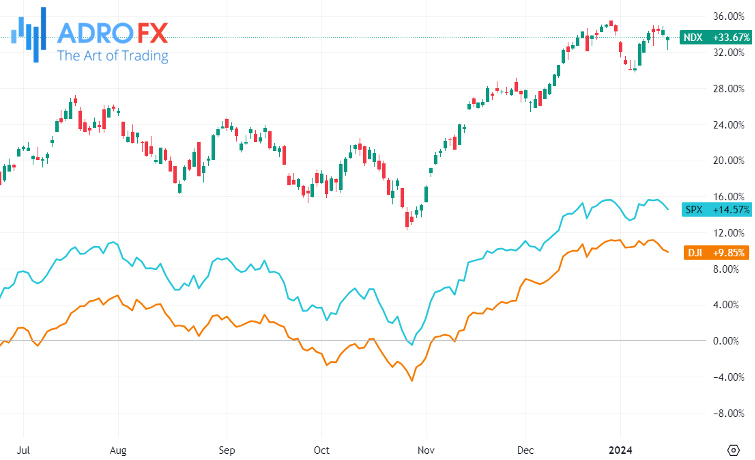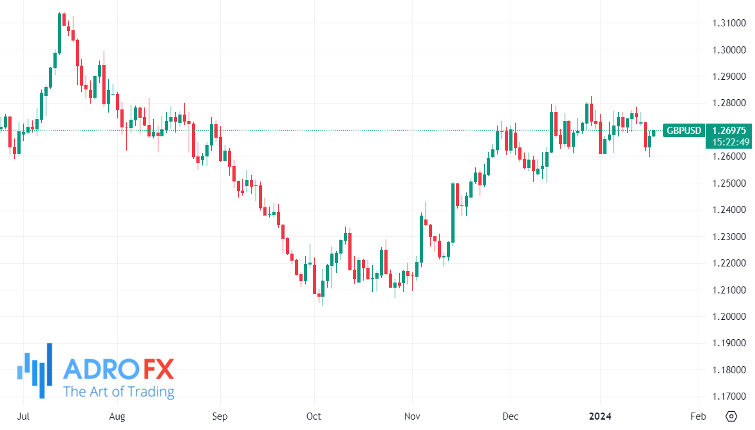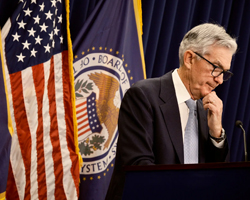Equities Decline on Rising Yields, Apple Faces Ban, and Global Currencies React | Daily Market Analysis

Key events:
- USA - Initial Jobless Claims
- USA - Philadelphia Fed Manufacturing Index (Jan)
- USA - Crude Oil Inventories
On Wednesday, US equities experienced a decline, influenced by a continued rise in Treasury yields that exerted pressure on the technology sector. The surge in yields was driven by robust economic data, creating uncertainty among investors about the likelihood of a Federal Reserve rate cut in March.
The Dow Jones Industrial Average witnessed a 206-point drop, equivalent to a 0.6% decrease, while the S&P 500 and NASDAQ Composite saw declines of 1% and 1.3%, respectively.

The prohibition on the sale of Apple Watch models featuring the blood oxygen monitoring feature in the US is set to be reinstated on Thursday. The US Court of Appeals for the Federal Circuit has rejected Apple's plea to continue importing these watches amid an ongoing patent dispute with medical device manufacturer Masimo (NASDAQ: MASI).
Initially, Apple faced a ban on selling watches equipped with the blood-oxygen monitoring feature in the US starting from December 26. However, a day later, the ban was temporarily lifted after a Federal appeals court granted Apple's emergency request, providing a pause to assess the company's plea for an extended lift of the ban. With the recent denial of Apple's request by the Court of Appeals, the ban is expected to be reimposed on Thursday, impacting the sale of Apple Watch models with the contested feature in the US market.
Tesla Inc (NASDAQ: TSLA) faced a 3% decline after reducing the prices of its Model Y in Europe, reigniting concerns about potential margin pressures. This move follows multiple price cuts by the electric vehicle manufacturer last year. Elon Musk's statement the day before, expressing a preference to "build products outside of Tesla" unless his stake in the company is raised to 25% from the current 13%, added to the negative sentiment surrounding Tesla.

Conversely, Boeing (NASDAQ: BA) observed a 1% increase after the Federal Aviation Administration announced the completion of preliminary inspections on 40 Boeing 737 Max 9 airplanes. This development raised hopes for the potential ungrounding of these airplanes, which had been indefinitely grounded for safety checks after an Alaska Airlines MAX 9 jet experienced a cabin panel blowout mid-flight, leading to an emergency landing.

During the early European session on Thursday, the GBP/USD pair is making gains below the 1.2700 barrier for the second consecutive day. This positive momentum is attributed to a shift in traders' expectations regarding an early interest rate cut by the Bank of England.

The UK Office for National Statistics (ONS) reported a notable development on Wednesday, revealing that the Consumer Price Index (CPI) increased to 4.0% in December, marking the first rise in 10 months. This was a significant upturn from the previous month's more-than-two-year low of 3.9%. Additionally, the core CPI, excluding volatile components like food, energy, alcohol, and tobacco prices, remained steady at 5.1% in December, defying expectations of a decline to 4.9%. As a result, market sentiment swiftly adjusted, with the probability of a BoE rate cut by mid-May decreasing from just over 80% on Tuesday to approximately 60%, providing support for the British Pound.
In contrast, the Japanese Yen experienced a slight uptick against the US Dollar during the Asian session on Thursday. This followed a three-day losing streak, partly due to weaker risk sentiment and subdued USD price action. Despite the JPY's safe-haven appeal, the upward potential is limited as the Bank of Japan is expected to maintain its ultra-dovish stance amid challenging circumstances, including a recent earthquake, declining inflation rates in Tokyo, and weaker wage growth.

Moreover, stronger-than-expected US Retail Sales data released on Wednesday contributed to a positive outlook for the US economy, reducing expectations for an early rate cut by the Federal Reserve (Fed). This, coupled with the widening US-Japan rate differential, suggests a potential upside for the USD/JPY pair.
The Australian Dollar struggled to recover losses incurred since January 11, influenced by robust US economic data and heightened geopolitical tensions.

The latest US military strikes on Houthi targets in Yemen increased risk aversion sentiment. Australia's economic data, released on Thursday, failed to provide significant support for the AUD. While Consumer Inflation Expectations remained stable at 4.5% in January, the Unemployment Rate stayed firm at 3.9% in line with December expectations. However, Employment Change data revealed a decline, with the number of employed individuals decreasing by 65.1K, contrary to the expected increase of 17.6K.









